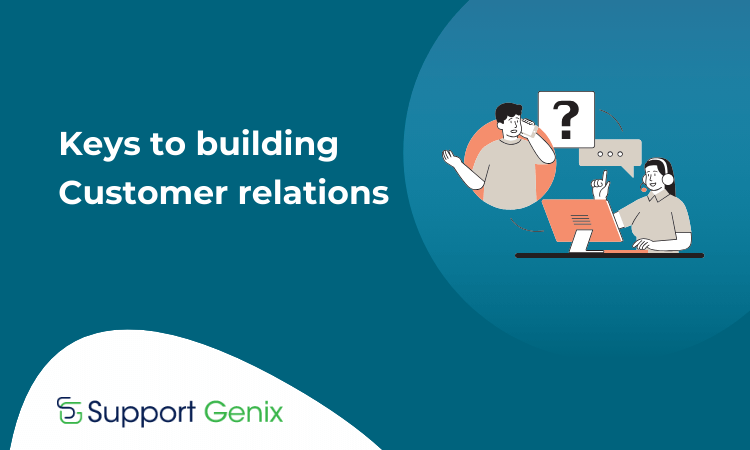19 Customer Behavior Models and Examples: Elevate Your Marketing Strategy
Ever wondered why customers make the choices they do? Understanding their behavior is key. Customer behavior models provide a solution, mapping out why people buy products.
A customer behavior model is a framework that predicts how consumers decide to purchase. This blog post dives into 19 essential models and real-world examples aimed at elevating your marketing strategy.
Discover how to apply these insights to connect with your audience better. Ready to transform your approach? Keep reading to unlock the secrets of customer behavior. Join us as we unravel the secrets behind successful customer engagement and business growth.
Support Genix
WordPress Support Ticket Plugin
Take Your Customer Support to The Next Level and Boost Customer Satisfaction Rates
What are Customer Behavior Models?
Customer behavior models are roadmaps that analyze and predict how consumers make purchasing decisions. They consider factors like attitudes, motivations, and external influences to understand why people buy products or services. These factors help businesses tailor their marketing strategies effectively.
According to a study conducted by McKinsey & Company, companies that effectively utilize customer behavior models experience a 10-15% increase in sales and a 20-30% increase in marketing ROI compared to those that do not utilize such models. (McKinsey & Company, “The CEO guide to the customer experience”, 2016.)
Analyzing customer behavior with these models helps businesses customize their marketing, products, and services to match what their customers want and expect.
Recommended Blogs for You:
👉 The Impact of a Customer Support Software on Your Business
👉 How Support Teams Impact Revenue: Harness the Power of Support
👉 8 Top Customer Communication Management Software Platforms
👉 The Power of Good Customer Support for Customer Retention
👉 Importance of Implementing a WordPress Support Ticket System for Your Website
19 Customer Behavior Models and Examples
Understanding customer behavior is important for creating effective marketing strategies. Customer behavior models can be classified into two different categories. These two types of models are the traditional model and the contemporary model. These are described below:
Traditional Customer Behavior Models
Traditional consumer behavior models encompass various frameworks that seek to explain how individuals make purchasing decisions based on their perceptions, motivations, and external influences:
1. Learning Model
The Learning Model suggests that customer behavior is shaped by past experiences. It believes that habits form when actions repeatedly lead to positive outcomes. This model helps marketers understand how consistent, positive brand experiences can build loyalty.
For example, if you always find what you need at a particular store, you’re likely to shop there often. This habit forms because the store consistently provides a good shopping experience. Marketers use this insight to ensure customer satisfaction, encouraging repeat business.
2. Psychoanalytical Model
The Psychoanalytical Model dives into the deeper motivations behind purchasing decisions. It explores how unconscious desires and needs drive consumer behavior. This perspective offers marketers a way to appeal to emotions and deeper desires.
Imagine choosing a car not just for its features but because it makes you feel successful. This choice is influenced by deeper, maybe unconscious desires for status and achievement. By tapping into these emotions, marketers can make products more appealing on an emotional level.
3. Sociological Model
The Sociological Model looks at how social factors influence buying behavior. It focuses on the impact of society, groups, and family on making purchasing decisions. This model is crucial for marketers aiming to leverage social trends and influences.
For instance, buying organic food because it’s popular in your social circle illustrates this model. Your choices are influenced by social norms and the desire to fit in. Understanding these social pressures helps marketers target their messages more effectively, based on societal trends and group dynamics.
4. Economic Model
The Economic Model assumes that customers make purchasing decisions rationally, based on the best value for their money. It views consumers as logical decision-makers who seek to maximize benefits while minimizing costs. This model guides marketers in emphasizing the value and efficiency of their products.
Consider comparing prices and features before buying a smartphone. This rational approach seeks the best balance of cost and functionality. By highlighting superior value or unique features, marketers can appeal to consumers’ desire to make rational, beneficial purchasing decisions.
Contemporary Consumer Behavior Models
Contemporary consumer behavior models have evolved to account for the dynamic nature of modern markets and the increasing complexity of consumer decision-making processes. Here are some contemporary models, along with examples demonstrating their relevance in today’s consumer landscape:
1. The Fogg Behavior Model
The Fogg Behavior Model says that for a behavior to happen, you need Motivation, Ability, and a Prompt to come together. If any of these elements is missing, the behavior won’t happen. This model, abbreviated as FBM, simplifies the comprehension of behaviors overall, offering a clear lens into their mechanisms.
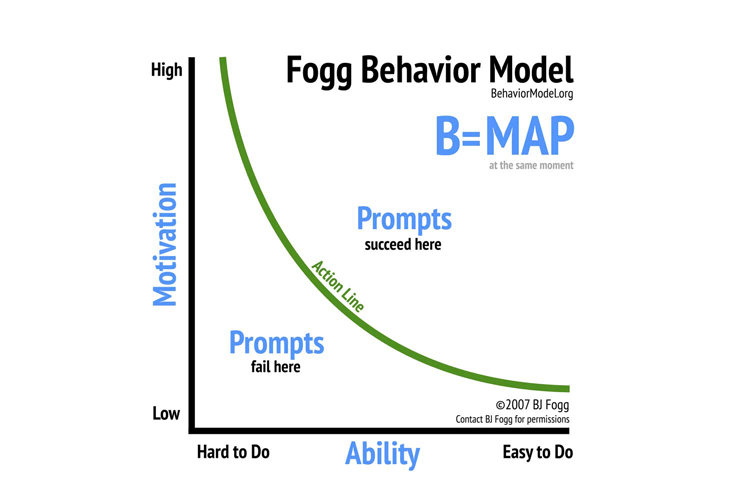
For instance, consider the purchase of a new smartphone. If someone wants the latest tech, can afford it, and sees a tempting discount, they will likely buy the smartphone. These motivations, abilities, and prompts make the purchase behavior more probable.
2. The Fishbein Model
The Fishbein Model predicts individual attitudes towards behaviors based on beliefs and evaluations. It suggests that the most favorable attitude leads to a specific behavior.
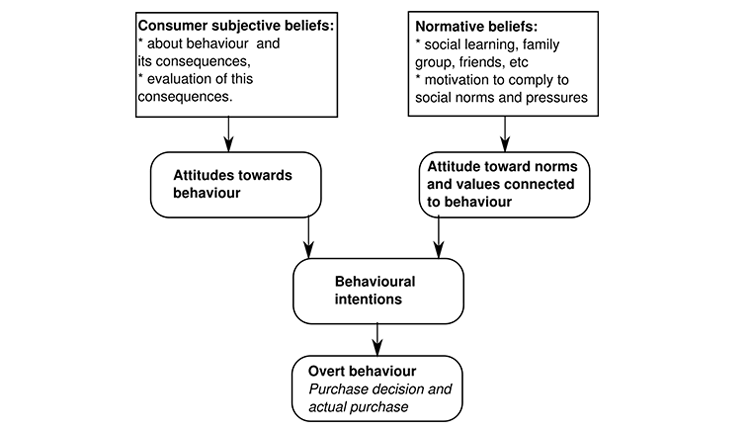
For instance, if someone believes that electric cars are environmentally friendly (belief) and values sustainability (evaluation), they’re more likely to purchase an electric vehicle.
3. The Howard-Sheth Model
The Howard-Sheth Model focuses on the importance of information in consumer decision-making. It outlines how consumers process information from different sources before making a purchase.
For example, a consumer might see an ad for a new smartphone (information source), consider its features and price, and decide to buy it based on these considerations. Satisfied with their choice, they establish loyalty, repeatedly selecting from the trusted brand.
4. The Elaboration Likelihood Model (ELM)
The Elaboration Likelihood Model explains how persuasion occurs through either central or peripheral routes. This depends on the individual’s motivation and ability to process a message.
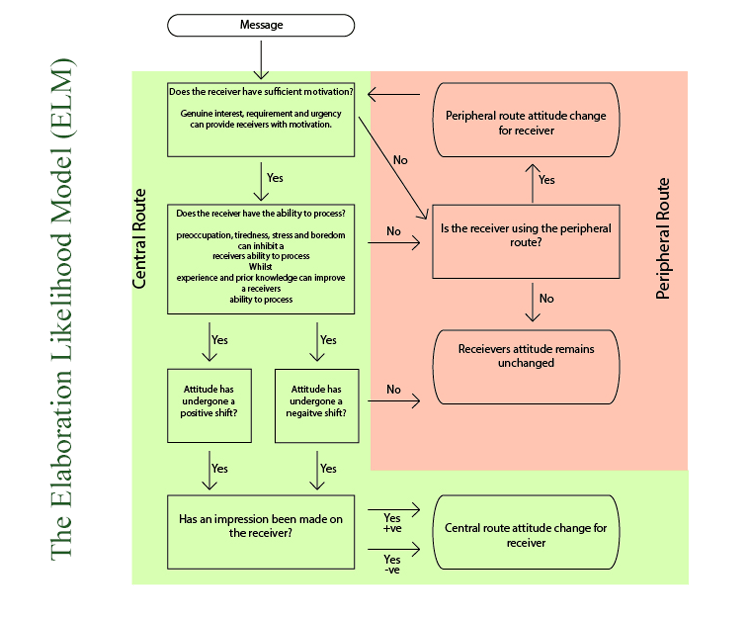
An example is a detailed product review (central route) to convince a highly interested buyer, while a celebrity endorsement (peripheral route) might persuade less involved consumers.
5. The Engel-Kollat-Blackwell Model
The Engel-Kollat-Blackwell (EKB) model describes a consumer’s buying process in five ordered steps, starting with awareness and ending with customer behavior analysis. These stages are problem recognition, information search, alternative evaluation, purchase decision, and post-purchase behavior.
It guides consumers from initial recognition of a need to evaluating the results of their purchase decisions. Understanding this process enables tailored content creation to engage customers effectively.
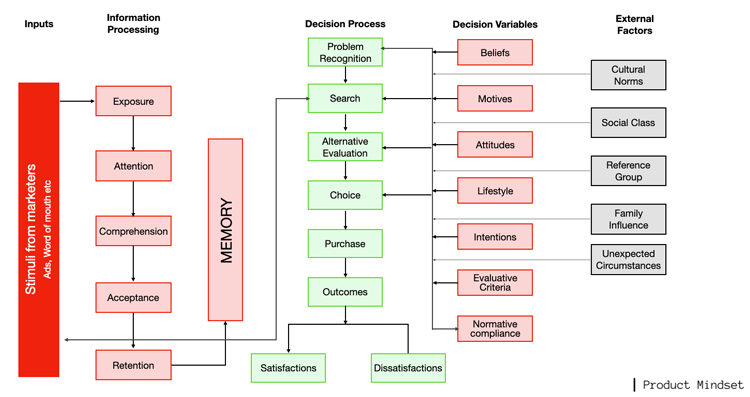
For instance, consider someone looking to buy a new laptop. The process begins when they recognize the need for a new device, either because their current one is failing or they require features it doesn’t have (problem recognition).
They move to online research, reading reviews, and asking friends for recommendations (information search). Next, they compare specs, prices, and warranties of different brands (alternative evaluation), decide on the one that best meets their needs (purchase decision), and finally reflect on their choice after using the new laptop (post-purchase behavior).
This could lead to satisfaction or dissatisfaction, influencing future purchases and potentially leading to brand loyalty or product returns. The EKB model highlights the complex interplay of factors at each stage, providing valuable insights for marketers aiming to influence consumer decisions.
6. The Stimulus-Response Model
The Black Box Model, or the stimulus-response model, likens each consumer’s mind to an opaque “black box.” When encountering external stimuli from your business, such as a marketing message, individuals process this information within their box of thoughts, experiences, and values.
For example, imagine a customer receiving a promotional email for a new gadget. This message interacts with their beliefs, motives, and lifestyle within their black box. They then decide whether to purchase based on this internal blend of factors.
By unraveling these elements, businesses can tailor their approach to resonate with the right audience, ensuring their products reach the intended consumers.
7. The Customer Lifetime Value (CLV) Model
The Customer Lifetime Value (CLV) model is a strategic tool in business. It aims to forecast the total value a customer will bring over their entire relationship with a company.
This approach delves into historical customer data, where behaviors and characteristics are the guiding stars. Businesses gain insights into spending patterns, preferences, and loyalty by segmenting customers. Sophisticated predictive models then crunch these numbers, estimating future value.
For instance, a coffee shop may discover its loyal morning regulars have a higher CLV due to daily purchases and consistent trade. This consumer behavior model isn’t just about the past; it’s a compass for future strategies, ensuring resources are focused where they matter most.
8. The AIDA Model
The AIDA Model, an acronym for Attention, Interest, Desire, and Action, serves as a roadmap for effective advertising. It delineates the journey consumers undertake when considering a purchase.
Firstly, attention is garnered through captivating visuals or compelling headlines.
Subsequently, interest is piqued by highlighting benefits or unique features. As desire is kindled through persuasive messaging or emotional appeals, the consumer is propelled toward action.
For instance, a well-crafted advertisement showcasing a luxurious vacation spot can captivate attention, spark interest with scenic imagery, evoke desire with promises of relaxation, and ultimately prompt action by encouraging bookings.
9. The B2B Customer Decision-Making Model
In the B2B Customer Decision-Making model, companies undergo a structured process to procure goods or services from other businesses. This journey entails meticulous evaluation before committing resources, beginning with problem identification and culminating in product selection.
For instance, a manufacturing firm may meticulously assess various suppliers before selecting a machinery provider to optimize production processes. This consumer behavior model ensures informed decisions, safeguards investments, and fosters efficient collaborations in the B2B landscape.
10. The Technology Acceptance Model (TAM)
The Technology Acceptance Model (TAM) suggests that a computer system’s acceptance hinges on perceived usefulness and ease of use. This consumer behavior model highlights the significance of users’ perceptions in determining adoption.
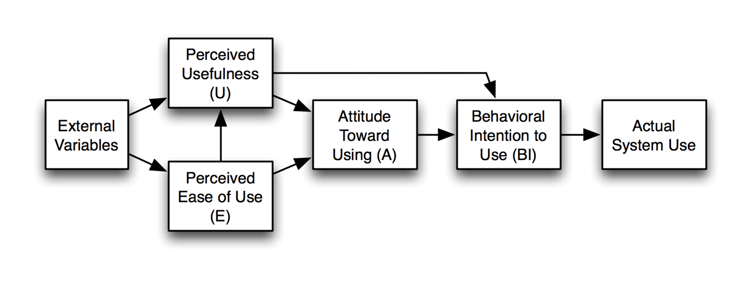
For instance, consider a new mobile banking app. If users perceive a technology as easy to use and believe it helps improve their financial management, they’re more likely to embrace it.
The Technology Acceptance Model (TAM) stresses the importance of user perceptions, underscoring the need for technology to align with user needs and preferences.
TAM emphasizes creating technology that meets user requirements to ensure acceptance and adoption. By prioritizing user-centric design, businesses can increase acceptance and adoption rates of their products or services.
11. The Theory of Planned Behavior
The Theory of Planned Behavior is like a map that helps us understand why people do what they do. It says that if we want to know whether someone will do something, we should look at three things.
First, how they feel about the action; do they think it’s good or bad? Second, what they believe their friends and family think about it? Do they feel pressure to do it or not? And third, whether they think they can easily do it. Is it within their power, or do they see obstacles?
For example, imagine someone thinking about eating healthier. If they believe it’s good for them, know their family supports the idea, and feel confident they can choose healthy foods, they’re more likely to do it. But if any of these feelings are negative, they might not try.
This theory helps in planning programs or advice to encourage good habits by focusing on changing feelings, beliefs about social pressure, and boosting confidence in ability.
12. The Transtheoretical Model (TTM)
The Transtheoretical Model (TTM) views customer behavior change as an evolving process, progressing through distinct stages over time. Each stage demands specific tasks for advancement, regardless of the duration spent in each phase.
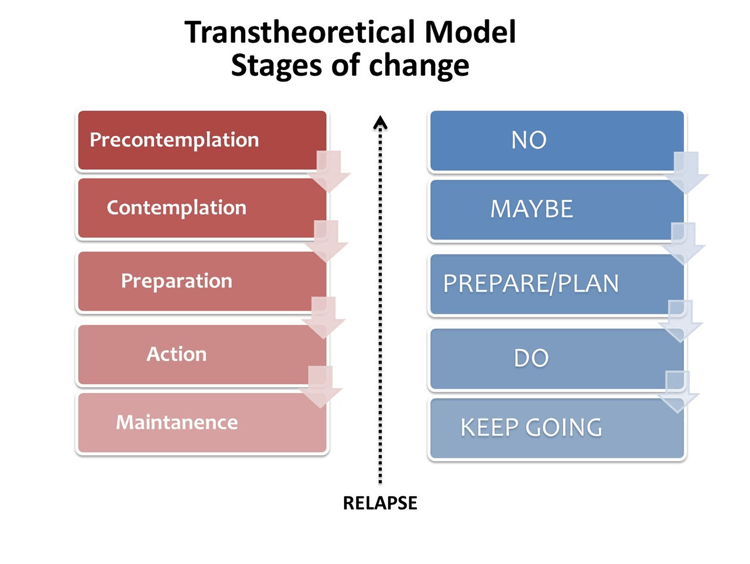
For instance, a customer moving from “awareness” to “consideration” in purchasing a product may require engaging with reviews and comparing options, irrespective of how long they spend in each stage.
13. The Hierarchy of Effects Model
The Hierarchy of Effects Model is like a ladder that explains how advertising works step by step to convince someone to buy something. Think of it as a journey where each step needs to be climbed before moving to the next one. There are six main steps: knowing, liking, wanting, preferring, being convinced, and finally buying.
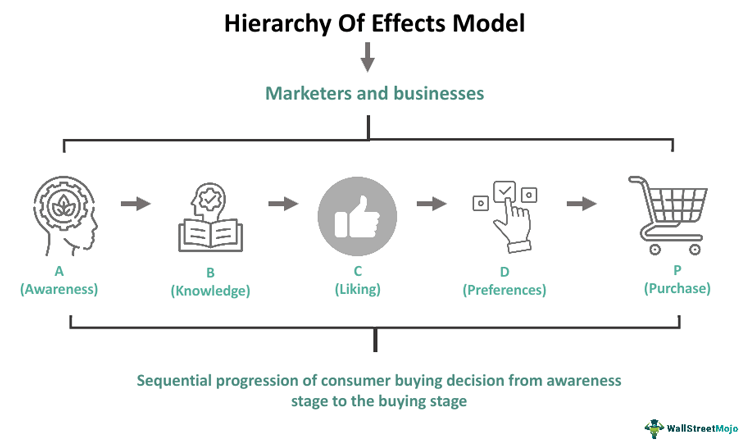
For example, imagine you see an ad for a new kind of chocolate bar. First, you learn it exists (knowing). Then, the ad tries to make you like it by showing how tasty it looks. If the ad does a good job, you might start wanting to try it.
Next, you might see more ads comparing this chocolate to others, making you prefer it over different brands. The ad will give you reasons why this chocolate is the best, convincing you. In the end, if all goes well, you’ll go out and buy the chocolate bar.
This model helps people who make ads understand how to guide someone from just hearing about a product to actually buying it.
14. The Consumer Style Inventory (CSI)
The Consumer Style Inventory (CSI) model proposes that consumers engage with the market through eight decision-making styles. Sproles revamped this model, delineating eight consumer styles driven by cognitive and personality traits. Each style represents a unique intellectual approach to consumption.
For instance, a consumer with a “brand-conscious” style may prioritize well-known labels, while someone with a “quality-conscious” style may prioritize product durability and craftsmanship. These styles shape individuals’ purchasing behaviors and preferences.
15. The Nicosia Model
The Nicosia model underlines the pivotal role of a company’s marketing strategies in shaping consumer purchasing decisions. While acknowledging the impact of marketing techniques, it recognizes that various factors influence consumer perceptions and choices. Therefore, some practitioners may integrate this consumer behavior model with others to gain a comprehensive understanding.
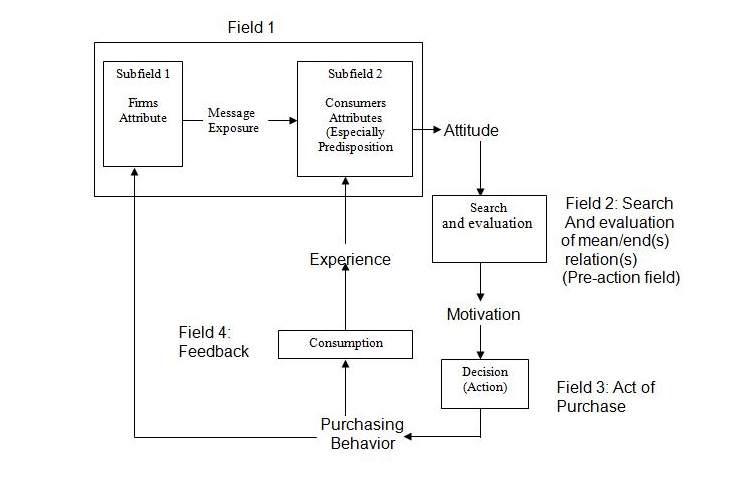
For example, a person notices an engaging ad for a revolutionary kitchen blender. Delighted, they research its features, comparing it to their current appliance. Convinced of its superiority, they decided to purchase this innovative kitchen tool. Their satisfaction with the purchase can lead to brand loyalty and future purchases.
Tips on How to Choose the Right Model(s) for Your Business.
Choosing the right model for your business involves considering various factors to ensure it aligns with your goals, industry, and target audience. Here are some tips to help you select the most suitable customer behavior model:
Understand Your Objectives: Clearly define the goals you want to achieve by understanding customer behavior. Whether it’s increasing sales, improving customer satisfaction, or launching a new product, your objectives will guide the choice of customer behavior models.
Know Your Industry: Different industries have distinct customer behaviors. Research industry-specific models that have proven effective for businesses similar to yours. Look for case studies and examples that demonstrate success.
Consider Your Customer Base: Analyze your target audience’s demographics, preferences, and buying habits. Choose a model that resonates with your customers and provides insights into their decision-making processes.
Evaluate Complexity vs. Practicality: Some models, like the Theory of Planned Behavior, are comprehensive but may require more data and customer behavior analysis. Consider the resources, time, and expertise needed to implement and interpret the model effectively.
Review Available Data: Assess the availability and quality of your data on customer behavior. Some models may require extensive customer surveys, while others can be applied with existing transactional data or market research.
Test and Iterate: Consider starting with a simpler model or a combination of models to see what works best for your business. Implement A/B testing or pilot studies to gather real-world insights and refine your approach.
Frequently Asked Questions
What is the black box model in consumer Behavior?
The black box model in consumer behavior focuses on inputs and outputs. It examines how external stimuli influence the consumer’s decision-making process without detailing the internal mechanisms.
What is the importance of AIDA model in digital marketing?
The AIDA model in digital marketing captures the customer’s attention, maintains interest, creates desire, and prompts action. It’s essential for guiding potential customers through the buying process effectively.
What is the difference between AIDA and customer journey?
The difference between AIDA and the customer journey lies in scope. AIDA focuses on leading a customer to purchase, while the customer journey encompasses the entire experience, from awareness to loyalty.
What is the AIDA model to boost your content marketing?
Boosting content marketing with the AIDA model starts by grabbing attention with compelling headlines. Keep interest with useful info, create desire with benefits, and drive actions with strong calls-to-action.
How do businesses use customer lifetime value?
Businesses use customer lifetime value to predict the total value a customer brings over their relationship with the company. This helps allocate marketing resources more efficiently and improves customer retention strategies.
Support Genix
WordPress Support Ticket Plugin
Take Your Customer Support to The Next Level and Boost Customer Satisfaction Rates
Conclusion
Customer behavior models are essential for businesses to understand consumer actions. They help craft targeted strategies based on preferences and trends, leading to increased engagement and conversions. By analyzing data, companies can optimize marketing efforts and improve customer experiences.
These models provide valuable insights for boosting satisfaction and loyalty. Using customer behavior models in business strategies is essential for long-term success and fostering strong customer relationships in a competitive market.
